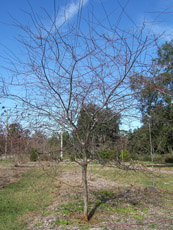Prunus angustifolia (Chickasaw Plum)

*Click on picture for more images of this species.
- USDA Hardiness Zone: 6A - 9B
- Mature Height: 12 to 20 ft
- Mature Spread: 15 to 30 ft
- Growth Rate: Moderate
- Availability: Available
- Drought Tolerance: High
- Salt Tolerance: Unknown
- Light Requirements: Full sun to partial sun.
- Native Origin: Native to Florida.
- Soil Drainage: Needs a well-drained site.
- Foliage: Deciduous tree with no showy fall color.
- Flowers: White, showy, fragrant flowers in the winter.
- Pests: Tent caterpillar can defoliate trees and weaken them.
Description: Growing 25 feet tall and wide, Chickasaw Plum forms a rounded mass of slender, thorny branches sprouting from a short trunk. In spring, before the one to two-inch-long leaves appear, Chickasaw Plum is festooned with small, white, fragrant flowers which make the trees quite decorative in the presence of other trees which are often still dormant. The 0.5-inch-diameter fruits which follow are red, ripening to yellow, and are extremely popular with wildlife and people. The plums are either eaten fresh or used to make a delicious jelly.
Grown occasionally with a single leader and used as a street tree, Chickasaw Plum is usually seen with a multiple trunk planted as a specimen or in a median strip, or planted on 15 to 25-foot-centers along the entrance road to a commercial property. It tends to sprout from the base of the trunk, forming multi- stemmed thickets. This is the form most commonly seen in its native habitat in old fields and in other disturbed sites. It makes a nice addition to the shrub border in the back yard and is well suited for planting around the patio or deck although it does not form a neat crown and looks a little unkempt during the winter. The crown often leans to one side or the other. Occasional pruning can significantly improve the form of the crown, especially when it is begun when trees are young.
A North American native tree, Chickasaw Plum is very easily grown and has no special cultural requirements. It tolerates drought, sandy or clay soil but does poorly in alkaline pH. These small trees grow quickly but have a relatively short life. This should not stop you from planting the tree since it will serve the landscape well during its life.
Gainesville Observations: This tree should be suited for planting near power lines. Tent caterpillars have been common on our trees. Although trees recover by growing a new set of foliage following caterpillar defoliation they are a mess when infested. Flowers have been reliable and beautiful in early to mid March. Our trees came with a short trunk (about 3 feet tall) which makes pruning to a dominant leader difficult but possible. Low branches droop toward the ground and require pruning for clearance under the canopy. Could be used as a street tree if trained to a central trunk.

